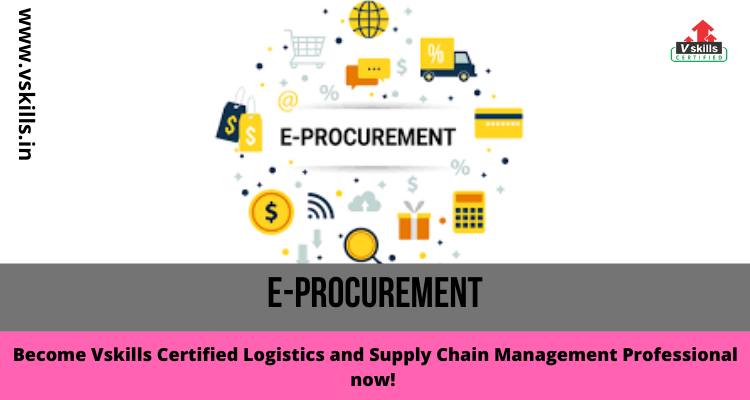E-procurement is the business-to-business purchase and sale of supplies and services over the Internet. It is an important part of B2B websites and is also called as supplier exchange. E-procurement Web sites only allow qualified and registered users to look for buyers or sellers of goods and services. Depending on the approach, buyers or sellers may specify prices or invite bids. Transactions can be initiated and completed. Ongoing purchases may qualify customers for volume discounts or special offers.
Due to usage of e-procurement system, organizations can significantly reduce the administrative costs of purchase. E-Procurement also helps with the decision-making process by keeping relevant procurement related information organized and time-stamped. Most of e-procurement system utilizes a template-driven system thus, making all transactions standardized and trackable. Keeping track of all bids can be leveraged to obtain better pricing. Companies can easily focus on their most lucrative trading partners and contracts.
Well-managed e-procurement also reduces inventory levels. The knowledge of product numbers, bid prices and contact points eases in closure of business deals by making available information relevant and timely. E-Procurement systems are equipped with different levels of access and permissions as per user’s role, group, or task. Further, as the e-procurement systems are standardized and easy to learn, it reduces the training time for end users to use the system.
The e-procurement system comprises of various sub-components which include indent management, e-Tendering, e-Auctioning, vendor management, catalogue management, Purchase Order Integration, Order Status, Ship Notice, e-Invoicing, e-Payment, and contract management. Indent management is the first step of workflow involved in the preparation of tenders and might be optional with individual procuring departments defining their indenting process. In works procurement, administrative approval and technical sanction are obtained in electronic format. In goods procurement, indent generation activity is done online. The end result of the stage is taken as inputs for issuing the notice inviting tender or NIT.
Sourcing is about establishing the best possible arrangements for the supply of bought in goods and services. The primary objective of sourcing is to find items of the best quality, at the best price, from suppliers who consistently supply correctly (right time right place). Once that has been accomplished the people in the organisation that need these items can then buy off the supply contracts (on-contract) that have been negotiated. Finally, the organisation must pay for the items. Organisational procurement has three distinct phases as
The e-procurement systems target two key areas of procurement which are the buying process and the sourcing.
E-procurement Process
The steps for e-procurement (electronic/web-based procurement) systems are
- Identify the needed Product or Service – Need occurs from employees or customers due to their requirements. With an e-procurement platform offers well-documented request time and date, easy request passing to the responsible parties electronically. Thus, helping in anticipating future requests, and improving response time. It may also involve, the requested product or service to be reviewed and approved which can be done automatically by an e-procurement system.
- Evaluate Suppliers – It is the crucial step of the procurement process. Suppliers not only provide product or service needed by the organization, but they also help in delivering quality at a competitive price in a timely manner. Good suppliers are searched by looking for suppliers registered with a national or international association like in automobiles, the Society of Automotive Engineers (SAE International) has a vast database of suppliers in several categories. After listing suppliers from association websites, ascertain the national/international quality standards certification for your specific industry. Also, request client names from each supplier and check with the customers for a basic background check.
- After the background check, negotiate terms and conditions for legally agreed upon rules of conduct during a purchase before adding it to approved supplier list. An e-procurement system can easily help users narrow down the group of suppliers and can track supplier performance based on quality, cost, and on-time delivery.
- Request for Quote, Review, and Place Order – After enlisting suppliers, issuance of request quotes (RFQs) from approved supplier initiates. An e-procurement system notifies the selected suppliers electronically, and requests for submission of their bids for the product or service, while securely keeping all the information in one place. After the receipt of all the bids (commercial and technical), the e-procurement systems enables bids review side-by-side and selection of the desired supplier to place the order with. The e-procurement system also notes the elapsed time throughout the bidding, review, and order placement stage for future improvement of the procurement process for the organization. When an order is placed through the system, an electronic Purchase Order (PO) is generated with all agreed terms and conditions of the purchase (quantity, cost, due date, payment process, etc.) and which is electronically routed to the selected supplier.
- Order fulfillment and Receipt – The time lag between order placement and order receipt is critical as problems might arise in fast paced environment with lots of specialized orders. Hence, supplier should always update the buyer on order status. E-procurement system improves communication by usage of automatic notifications as per the milestones reached by the supplier and improving transparency and productivity.
- After the fulfillment of an order, inspection is done to check for meeting of all agreed criteria, terms and conditions after which, the payment process is completed as per agreed commercial terms. The e-procurement system tracks milestones and documents the order quality. Payments can also be processed electronically by the system.
- Measure Performance – E-procurement system provide access to all of the tracked data in an actionable format. Thus, users can easily identify suppliers performance on the basis of cost, delivery time, and order quality while, replace the worst performers with new ones. Data from e-procurement system highlights organizational bottlenecks and help in effective resource allocation.

